
If you landed right here, right now, the chances are pretty high that you have run into one of the dreaded deficiencies that even the most experienced weed farmers face from time to time. Show me a grower who has been in the game for more than a few seasons and who also claims never to have had a single issue with deficiencies, and I’ll show you someone who is either lying or extremely lucky.
The nutritional needs of cannabis plants are surprisingly wide-ranging and change as the plants grow and move through the different stages of their life cycle. Like all living things, they require a balance of nutrients to thrive, and when these are deficient or imbalanced, problems can easily arise. Thankfully, the plants themselves will display symptoms of any deficiencies they may be experiencing, making it a little easier for us to diagnose and pin down the exact issue. But these signs can also be somewhat confusing, especially if you are just starting down the cultivation road.
In today’s Premium Cultivars grow guide, we’ll go through all the essential information about cannabis deficiencies, including their causes, how to identify them, and most importantly – how to fix them. But first, let’s have a quick chat about the nutrient needs of our green friends.
Just like humans, cannabis plants require a balanced intake of macronutrients (more commonly referred to simply as macros) to survive and thrive. These are the primary nutrients required in copious quantities for healthy growth – nitrogen (N), phosphorus (P) and potassium (K).
If you have already started growing the sticky-icky, then you should recognize these from those three little numbers on fertilizer labels, known as the NPK ratio. Nitrogen helps with vegetative growth, phosphorus is critical for bud and root development, and potassium plays a role in overall plant strength and health.
Think of this kind of like the fat, protein, and carbohydrates in our diets. All are necessary for different bodily functions, but too much or too little of any one of them can lead to some serious issues.
But that’s not all a plant needs to hit those final yield numbers we all hope for, or even to stay healthy during the entire growing cycle – there are also secondary macronutrients.
Along with the macros, there are also important micronutrients that cannabis needs to thrive – iron (Fe), manganese (Mn), copper (Cu), zinc (Zn), boron (B), and a few others. These are needed in much smaller quantities, hence the “micro” moniker.
You can think of these in the same way as the vitamins and minerals we need in our diets. They may not be needed in large quantities, or even all the time, but they are just as essential as the macros if you want to reach the yield numbers you’ve been dreaming of.
As cultivators, it’s pretty essential to learn the difference between mobile and immobile nutrients. Doing so will help you diagnose the issue when signs of deficiency appear.
Mobile nutrients are the ones that the plant is able to move throughout the entire structure as needed. If there is a shortage in one section, it can be taken from another part of the plant to compensate. Nitrogen is an example of a mobile nutrient (all macros are mobile) – if there is a deficiency in the leaves, nitrogen can be moved from the older leaves to help the new growth. This means that, for the most part, mobile nutrient deficiencies will first show up in the older growth, and most often on the lower, larger fan leaves.
Then we have the immobile nutrients. Unlike mobile nutes, these cannot be easily transported throughout the plant, so immobile nutrient deficiencies will usually first appear in the newer, upper parts of the plant. Calcium (Ca) and sulfur (S) are both examples of immobile nutrients.
New growers will often underestimate the importance of making sure the root zone pH is balanced. Even if you are providing all the nutrients your plants need, if the pH isn’t within a certain range, they won’t be able to absorb them efficiently – and that’s when deficiencies start to show up.
The ideal pH for cannabis plants is between 6.0-7.0 in soil and 5.5-6.5 in hydroponic or coco-coir setups, but some strains may have slightly different preferences, so it’s essential to monitor your particular plants closely. Different nutrients also have a slightly different pH range in which they are most readily absorbed, so slightly varying the pH of your feed water or nutrient solution (while staying within the correct range) throughout the growing period is a good practice.
If you don’t look after the pH, your plants may start to show signs of deficiencies even though you are providing them with plenty of nutrients. This is known as nutrient lockout, and can display similar symptoms to actual deficiencies, making it even more confusing for growers trying to diagnose the problem.
How do you effectively measure the pH of your grow medium?
The most reliable way is to use a digital pH meter, as they are easier and more accurate than testing strips. If you are growing with organic soil, then you can test the water before adding it to the soil, as this will give you a general idea of what your root zone pH is.
When growing in hydroponic or coco-coir setups, you should always test the nutrient solution before every single feeding. This is because the pH can change quickly, and if it becomes too acidic or alkaline, your plants will struggle to take up any nutrients at all.
Soil and coco growers can also measure the runoff (the water coming out of the pots after watering), which will also give an estimate of the pH at the roots. Hydro growers can simply measure the pH of their reservoir solution.
This is a difficult question to give one single answer for, as different deficiencies will display diverse and distinct symptoms. However, here are some general signs to look out for:
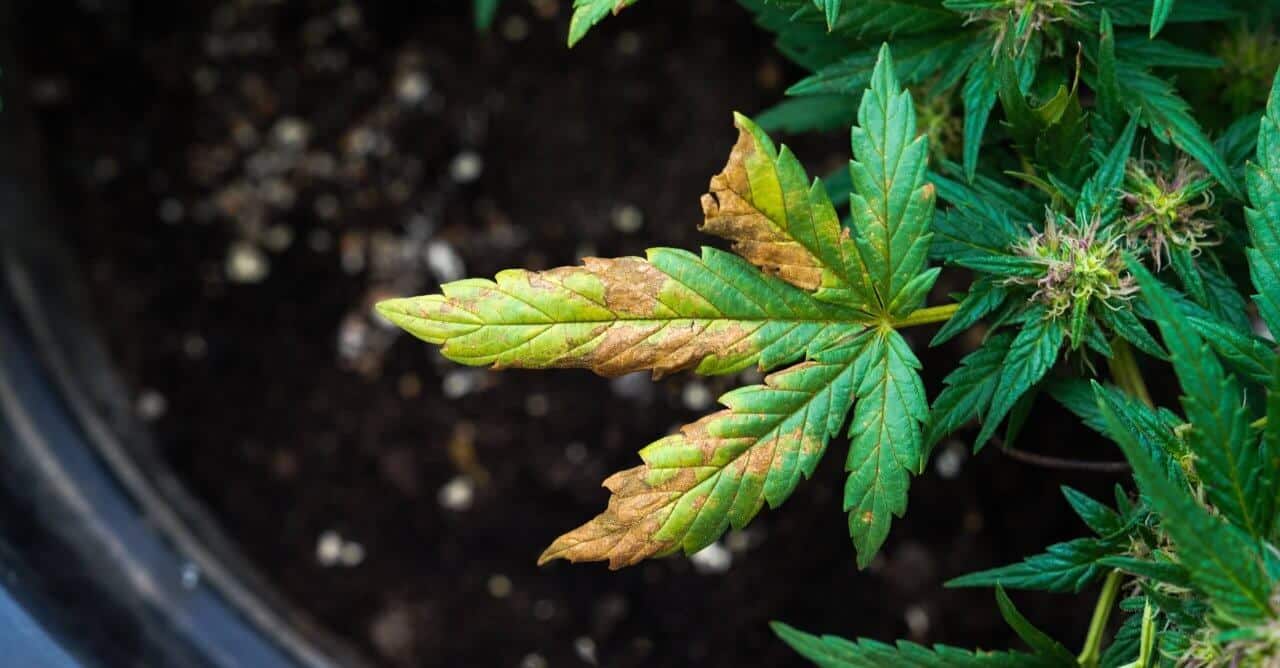
We will go into more detail on all the specific deficiencies a little further down, but first, let’s talk about some general cultivation rules that can help you prevent (or fix) any deficiencies that may arise.
The best way to avoid deficiencies is to take preventative measures and keep your plants healthy from the very beginning. Here are some general tips for preventing deficiencies:
If you think you may have run into a deficiency issue, there are a couple of things you should do straight away.
Remember, prevention is always better than trying to cure a deficiency after it has already affected your plants. Keep a close eye on pH, nutrient levels, and overall plant health to catch any potential issues early on and prevent them from becoming bigger problems down the line.
Ok, so let’s get into the guts of today’s write-up.
If you have already made sure that the pH levels are within the correct range, allowing you to rule out lockout as the issue, then you can start to diagnose what is causing your plant’s deficiencies. As mentioned earlier, each deficiency will display different symptoms, so it’s crucial to take note of what you are seeing and cross-reference it with the following list.
Nitrogen (N), a mobile nutrient, is essential for plant growth and overall development of the structure, especially during the vegetative stage. Nitrogen deficiencies are characterized by yellowing leaves, usually starting at the bottom of the plant and moving upwards.
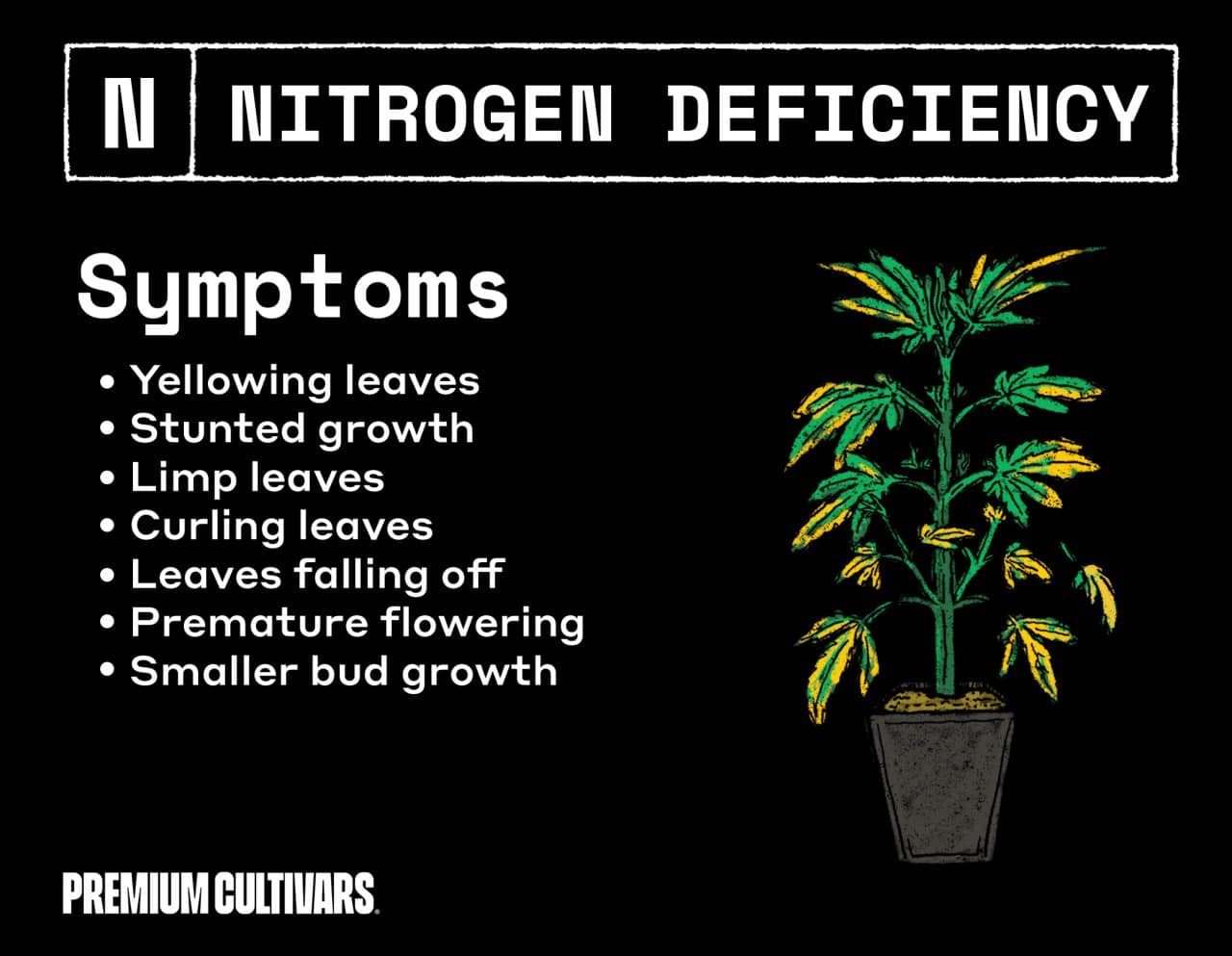
If the nitrogen issue isn’t fixed quickly, you will see the yellowing progressing up the plant, with possible discoloration and brown spots at the leaf edges, and the leaves will eventually curl and fall off the plant.
For soil growers, you can increase the nitrogen levels with a compost tea applied as a foliar spray or added to your watering schedule. Certain additives, such as ammonium nitrate, ammonium sulfate, fish meal, and alfalfa are all great for boosting nitrogen levels.
Coco-coir/hydro growers boost the nitrogen levels in their nutrient solution by adding in extra N-based nutrients such as urea, potassium nitrate, and calcium nitrate. Just remember not to overdo it, and always check the pH before feeding.
The second most important macro for weed plants is phosphorus (P). Phosphorus (mobile) is, in large part, responsible for the structural integrity of the plant. It’s also essential for proper root development, it increases resistance against diseases and pests, and plays a huge role in photosynthesis, among a range of other functions.
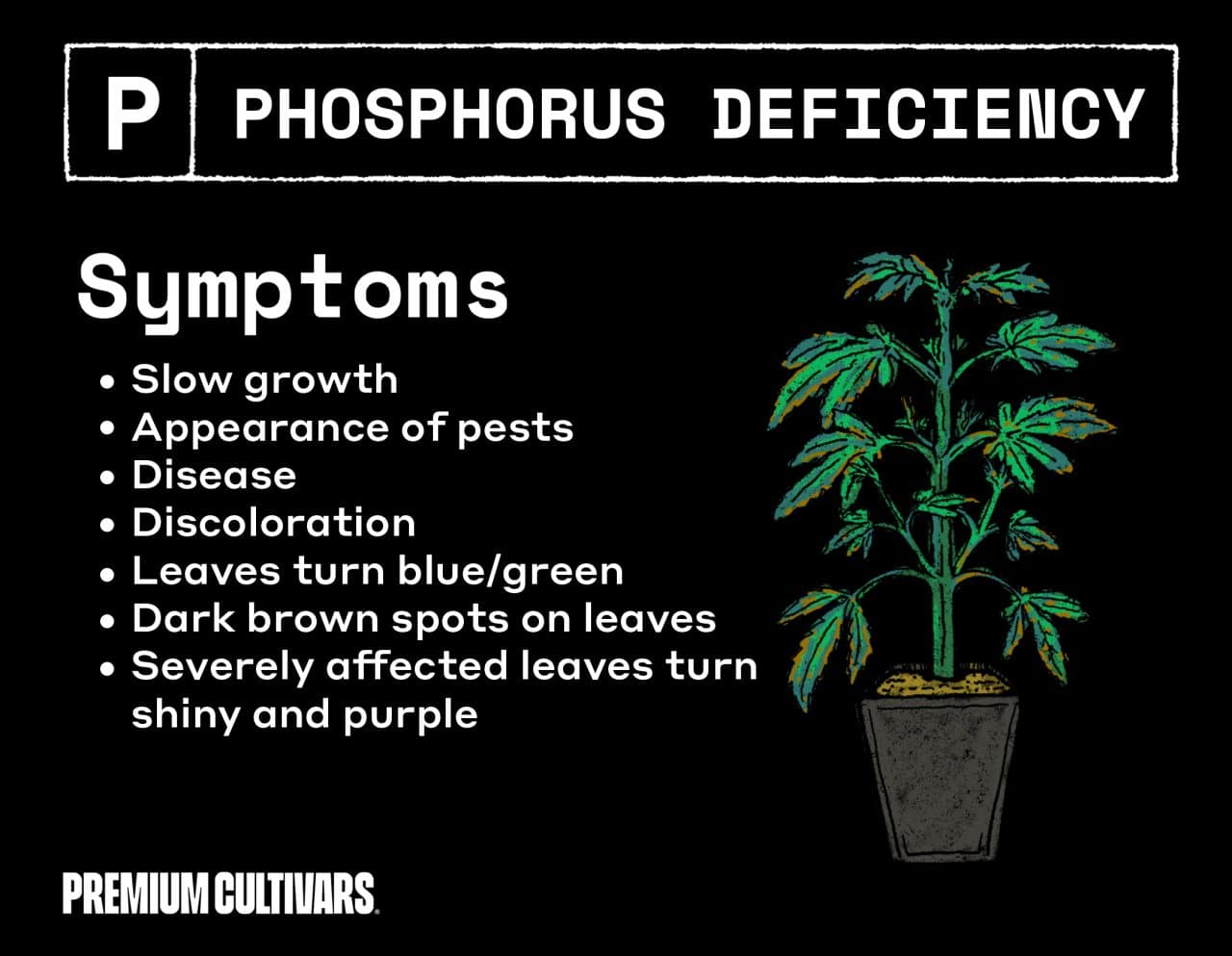
A phosphorus cannabis deficiency will usually present with the older leaf growth turning a very dark green or even gray, and with the leaf stems (or even branches) turning a bright red. If untreated, these symptoms can be joined by the fan leaves becoming thicker, and more brittle. You may even see some brown or purple spots popping up on the leaves.
Once you have ensured that pH isn’t an issue, you can start to boost the phosphorus levels by using organic fertilizers such as bone or fish meal, worm castings, or bat guano. Inorganic fertilizers that contain potassium phosphate are also particularly useful for increasing phosphorus levels.
Potassium (K), also mobile, is the last of the macros. It aids in the development of robust roots, increased growth rates, and is essential in boosting flower production during the flowering stage. By regulating CO₂ uptake, it also plays an integral role in photosynthesis.
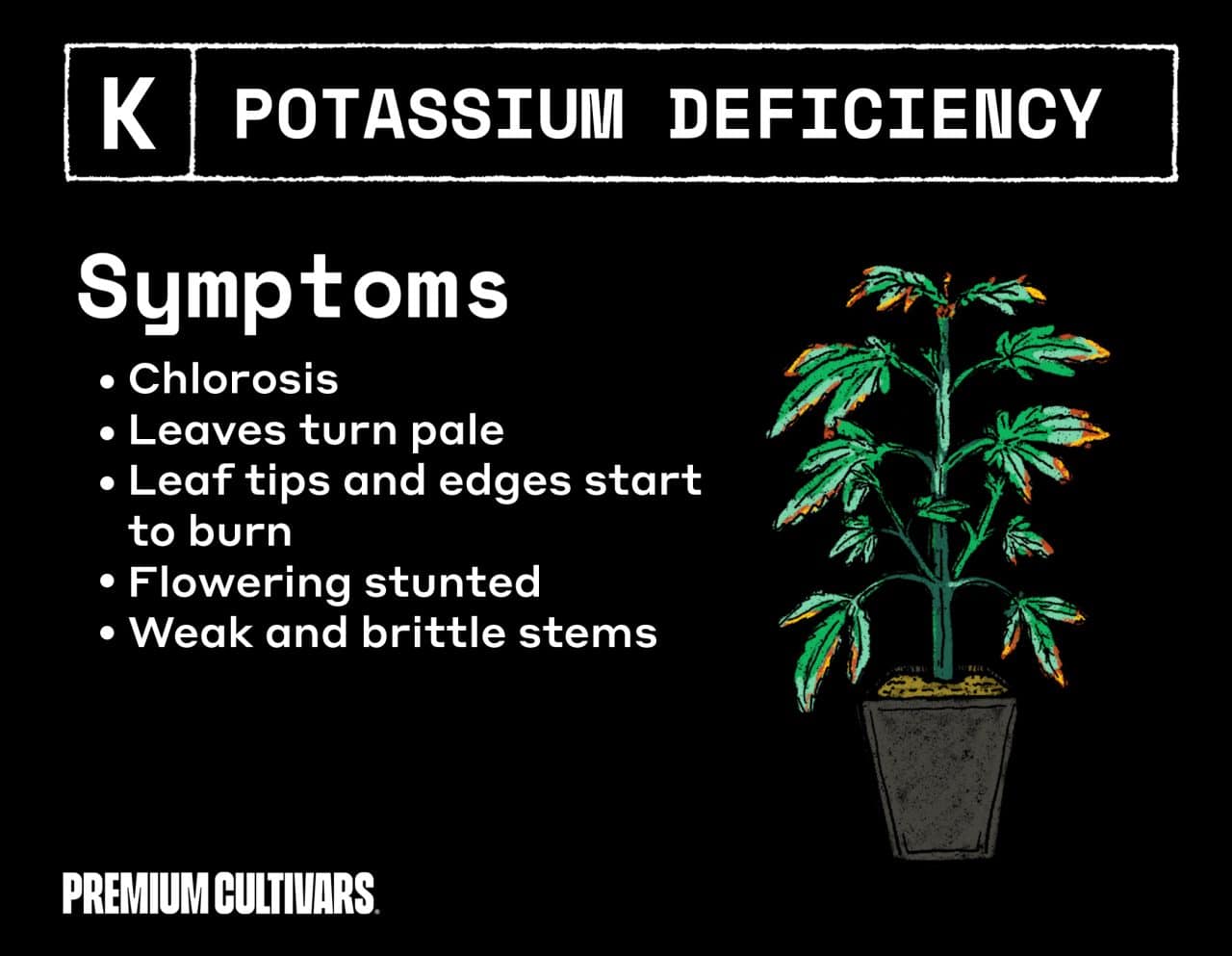
A cannabis potassium deficiency will usually present itself by showing yellowing leaves at the bottom of the plant, which then moves up towards the top. With potassium issues, the leaf veins will often remain a vibrant green, while the rest of the leaf yellows. Brown spots can then appear at the end of each leaf ‘finger’ as the issue develops further.
Organic seaweed compost teas are a great option for foliar application or adding to your watering schedule for soil growers. For coco-coir/hydro growers, you can increase potassium levels by using potassium sulfate or potassium nitrate. Just remember to check that pH before feeding.
Magnesium (mobile) is essential in the production of chlorophyll, which is responsible for making our plants green, but more importantly, it aids in the conversion of light energy into sugars for growth and development. It also helps in the absorption and transportation of phosphorus within the plant.
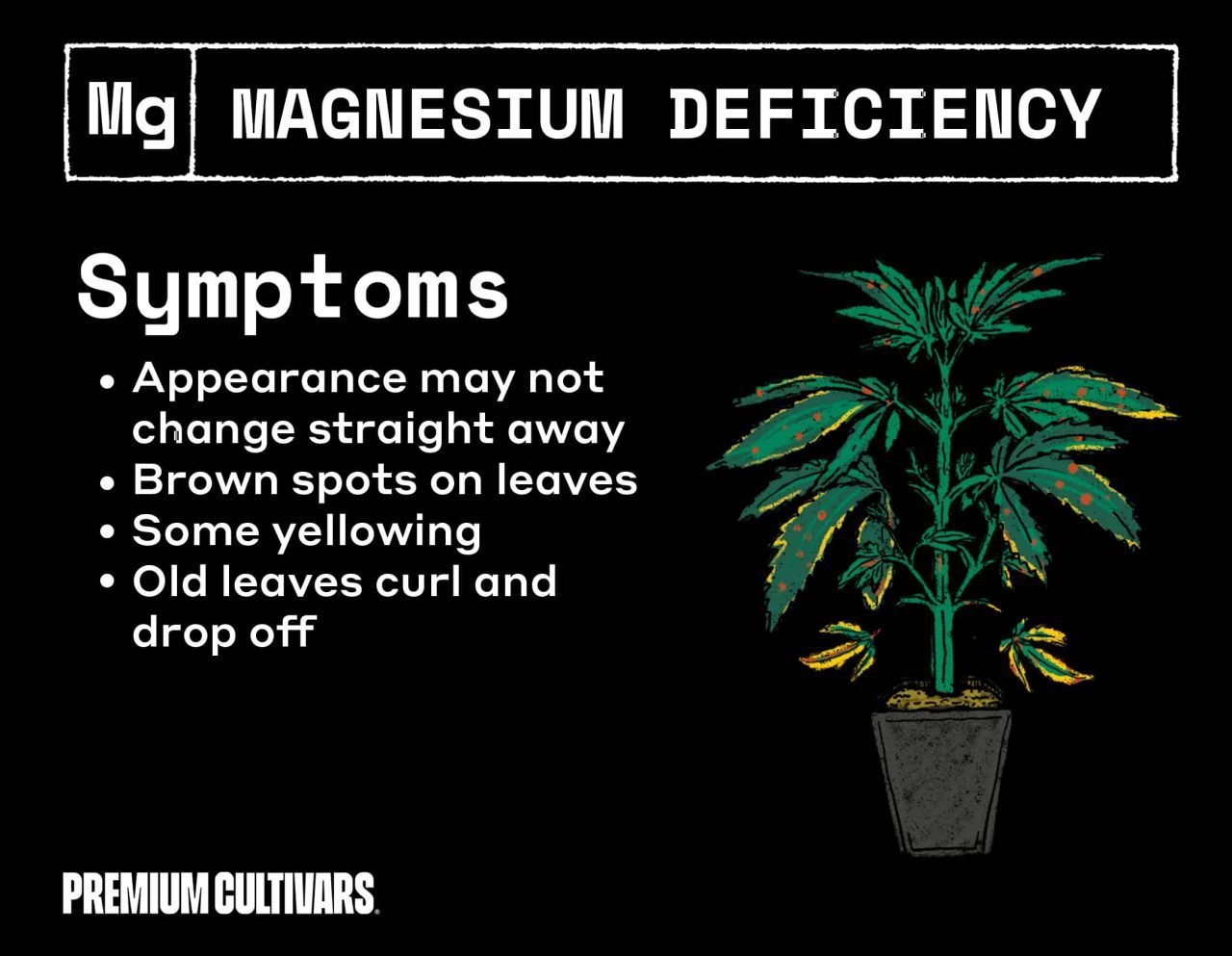
A magnesium weed deficiency can be spotted by yellowing leaves at the bottom of your plants, typically starting from the veins and edges, then moving inward. Stemming from this, you will see a mottled/patterned appearance to the leaves. If left untreated, the newer growth can also become affected, with the fresh shoots turning a purple or brown color, and the growth slowing to a halt.
Soil growers can correct this by applying a magnesium-rich Epsom salt solution to the soil, as well as adding dolomite lime. For coco-coir/hydro growers, you can grab a magnesium supplement to add to your nutrient solution.
Calcium (Ca), an immobile micronutrient that is actually almost as important as the three macros, strengthens the structure of the cell walls, boosting the strength of the stems, leaves, and roots. It is also a vital part of nutrient uptake, which means that if you do run into a calcium deficiency, there’s a high chance that other deficiencies may follow.
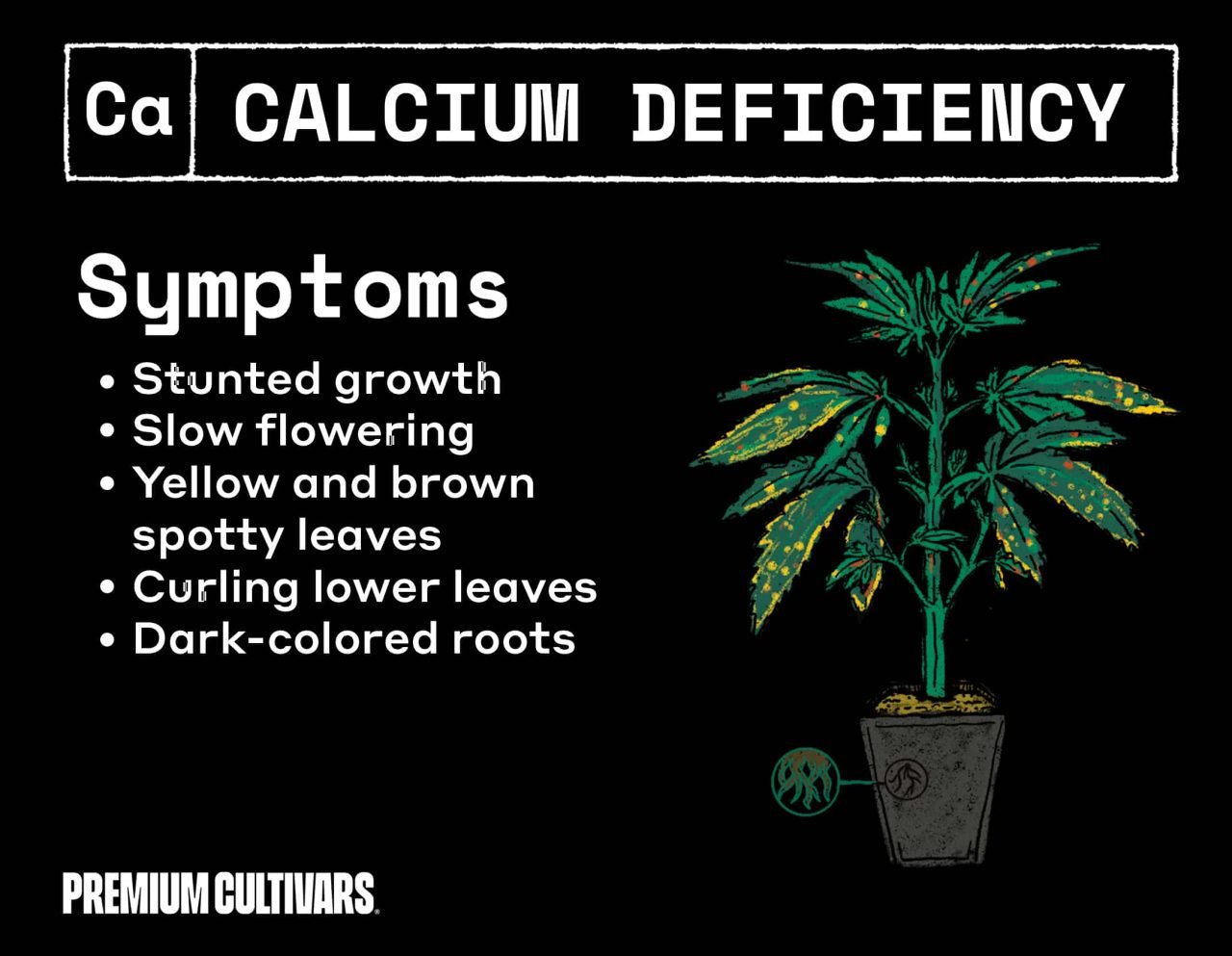
A calcium deficiency can be recognized by younger leaves near the top of the plant turning yellow at first and eventually developing brown spots or edges. The leaf tips may twist and curl, and the plant may even begin to droop or wilt.
For soil growers, you can add crushed eggshells or dolomite lime to your soil mix or use a calcium-rich amendment like gypsum. Coco-coir/hydro growers can increase calcium levels by using a calcium supplement, with calmag usually doing the job. Always check the pH before feeding.
Boron is an immobile micronutrient that works hand-in-hand with calcium to ensure proper cell wall development. It also helps plants to use other nutrients effectively, and it is crucial in flower and pollen production.
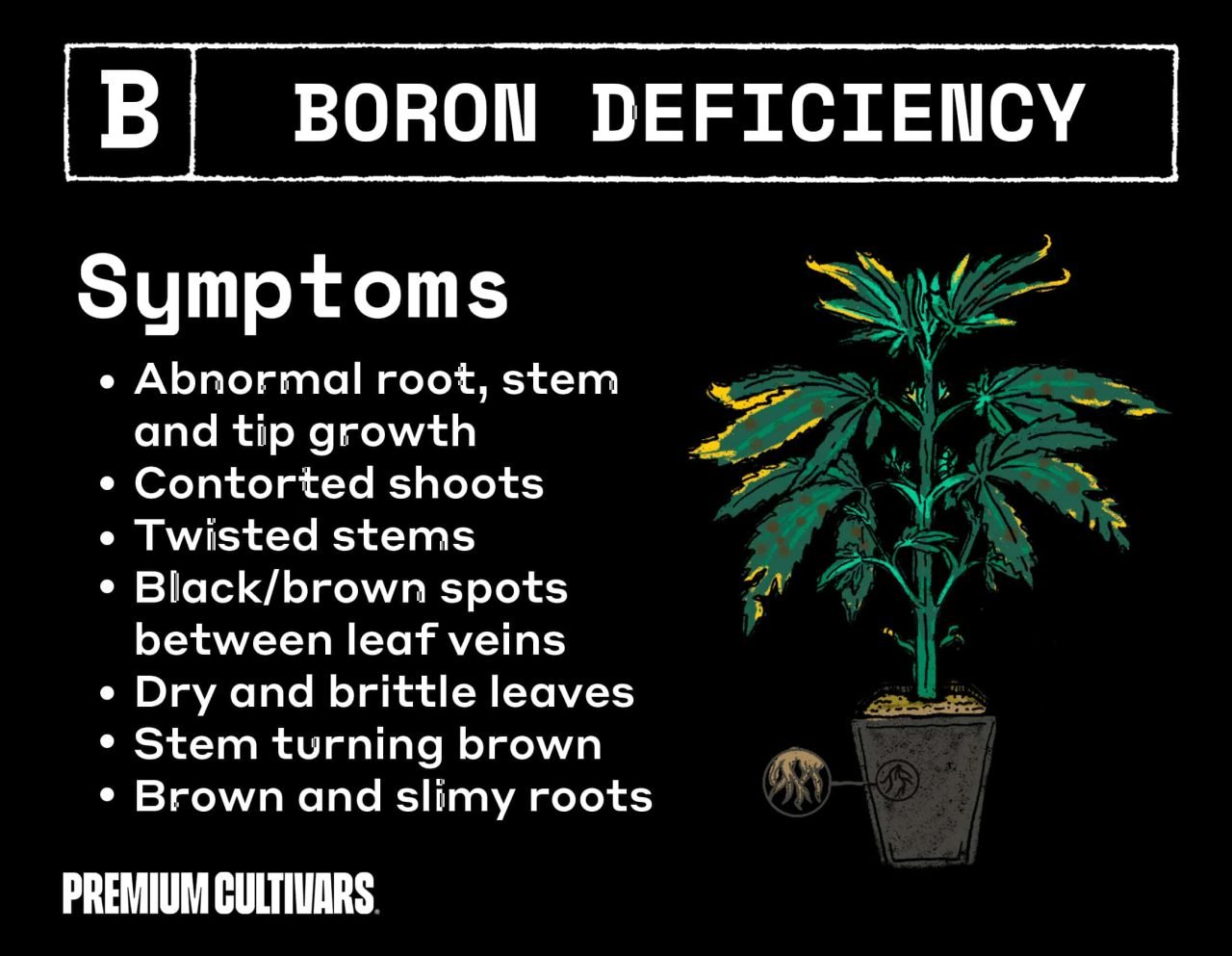
A boron deficiency will often manifest as distorted or twisted growth at the top of the plant, along with discoloration of newer leaves. You may also notice that stems or roots become deformed, and lateral growth increasing while newer shoots slow.
Your best friend in the fight against a boron deficiency is boric acid. By mixing a teaspoon or so with a gallon of water, soil growers can water the plants directly with this mix. Coco-coir/hydro growers can use it as a foliar spray or add it to the nutrient solution.
Copper deficiencies are a pretty rare occurrence, but that doesn’t mean you won’t run into them at some point. Copper is crucial in the production of chlorophyll, and without it, plants would simply not be able to photosynthesize. It also plays a role in root development and overall plant health.
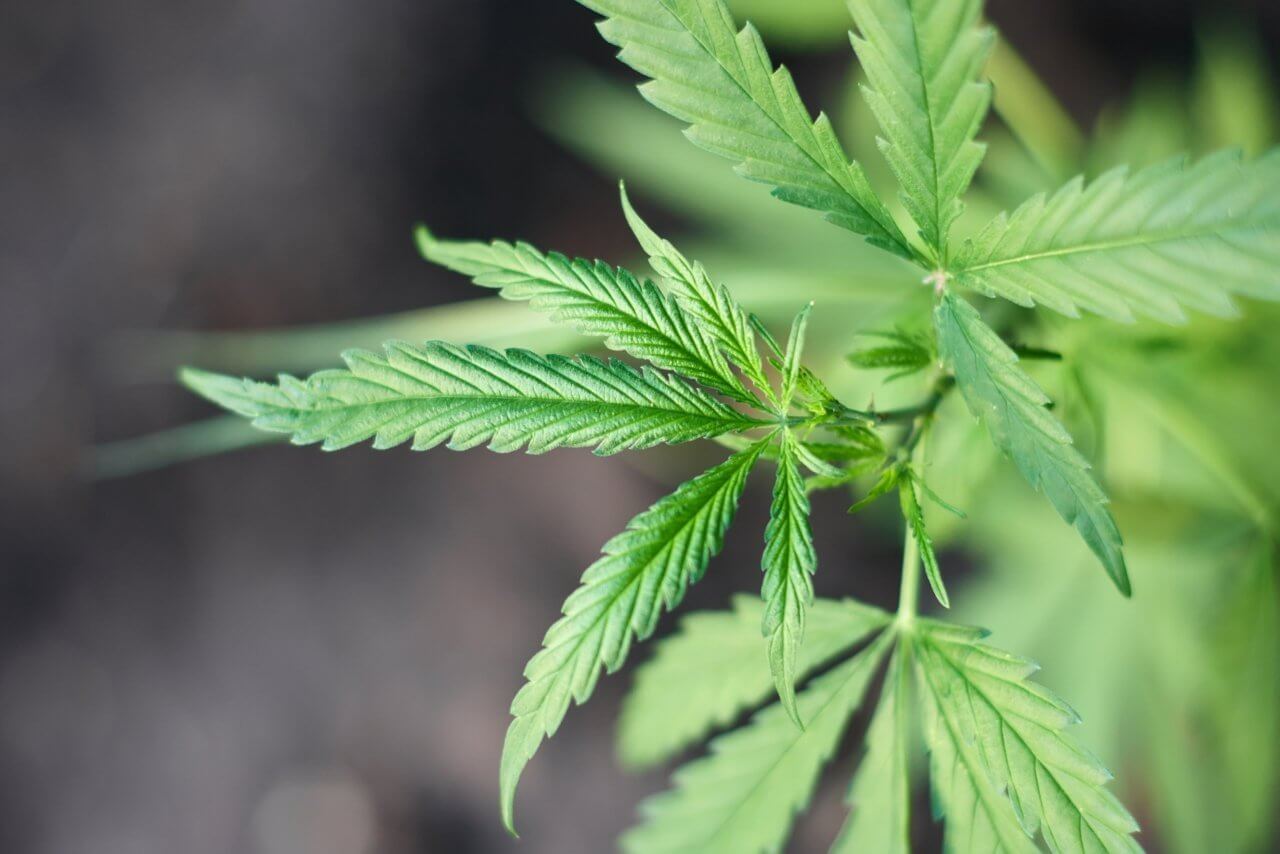
As copper is an immobile micronutrient, symptoms will first show on newer growth. You may notice the edges of fan leaves turning bright white or light yellow, with the remaining leaf turning dark purple or blue. The leaves may also take on a metallic sheen, and if the plant is already flowering, bud production may slow severely.
Find out more about flowering stage nutrient deficiencies.
Kelp, greensand, and high-quality compost mixes can be used to treat organic crops suffering from a copper deficiency. For inorganic fertilizers, you can use a supplement like copper sulfate, but be careful not to overdo it as too much copper can be toxic for plants.
This immobile micronutrient is vital for energy production, metabolic processes, and the production of chlorophyll. It is also crucial in the absorption and transportation of nutrients throughout the plant.
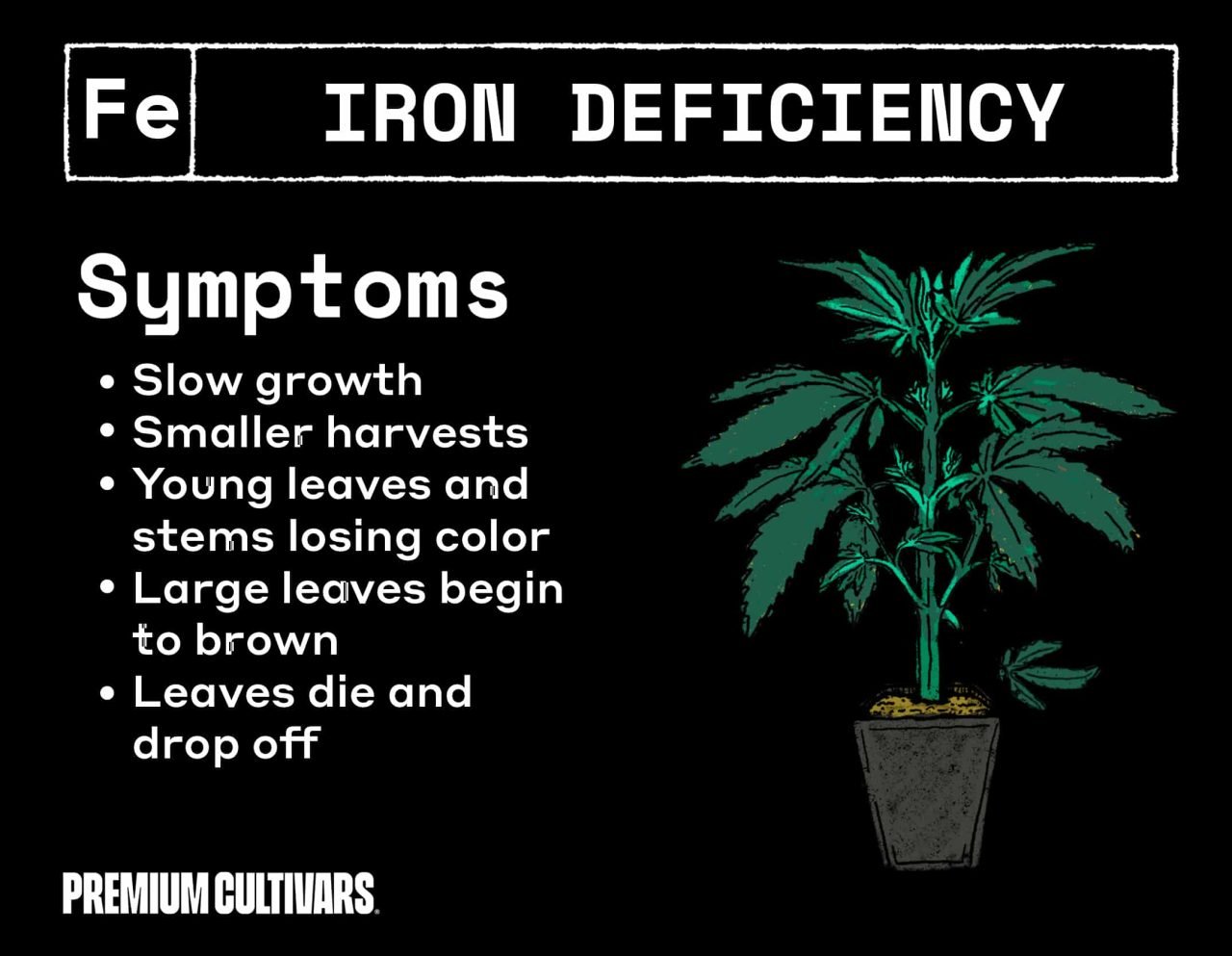
Iron deficiencies in weed plants are easily identified by yellowing leaves with green veins, similar to a nitrogen issue, but without the purple stems. The yellowing will usually start at the top of the plant, and if left untreated, it will spread to all leaves. If you don’t act quickly, the fan leaves will all yellow heavily, with the leaf veins turning a dark blue or even black.
Organic growers can increase iron levels by using compost or a foliar spray of fermented plant juice made from iron-rich plants. For inorganic cultivation, you can use iron chelate as a supplement. Just be careful not to overdo it, as too much iron can also be toxic for plants.
Manganese is an immobile micro that is essential in nitrogen uptake, respiration, photosynthesis, and root cell production and health. Manganese issues are not a common occurrence and are typically a sign of other underlying issues, such as improper pH or nutrient imbalances.
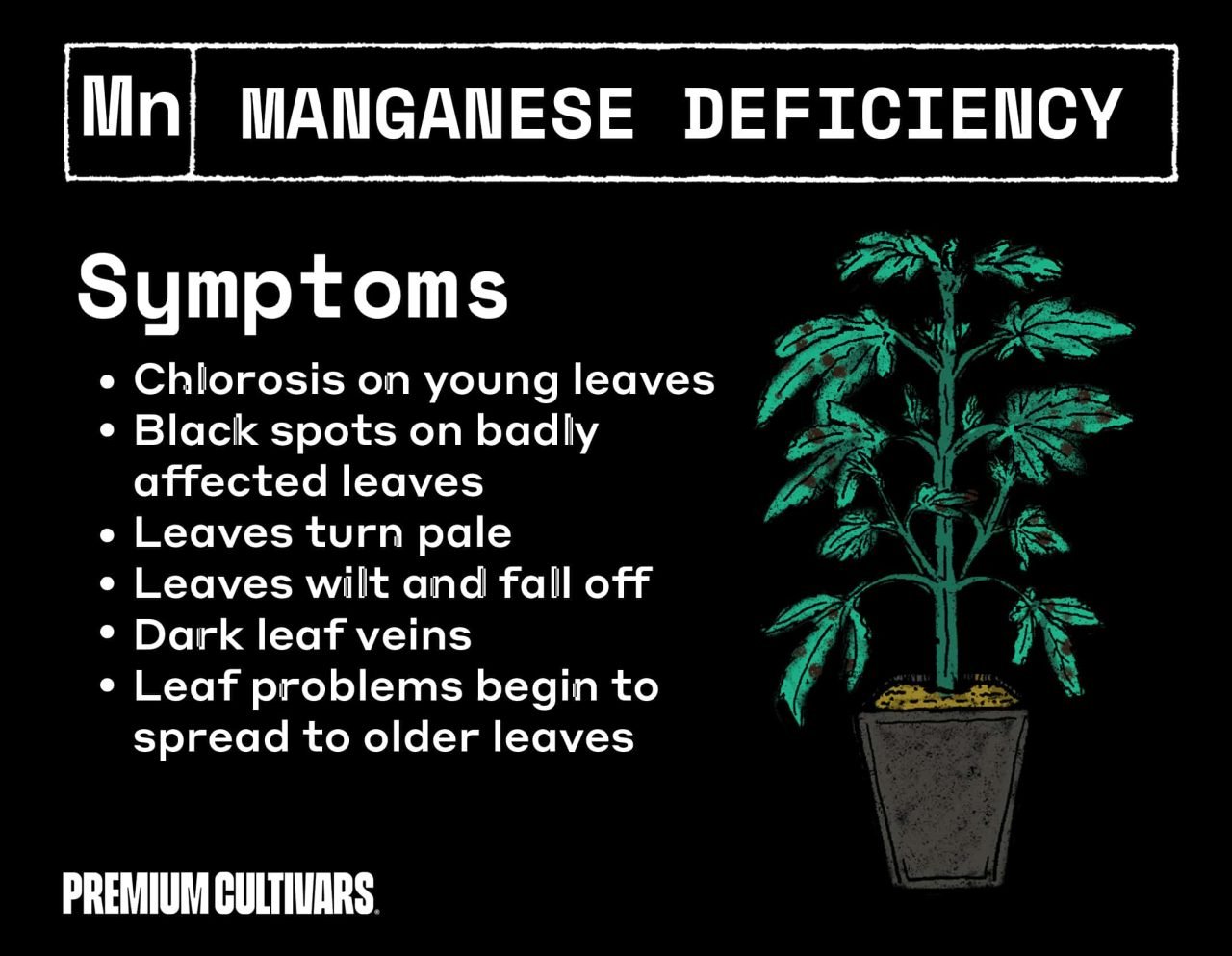
A manganese deficiency can be identified by new growth yellowing the base of the leaf, and dark orange or rust-colored spots and splotches appearing. Older leaves may have yellowing between the veins, which will eventually spread to the whole leaf. You may also notice stunted growth and twisted or misshapen leaves.
For soil growers, a seaweed based liquid fertilizer or compost tea can help increase manganese levels. Hydro and coco growers can also use a seaweed-based product or a manganese supplement like manganese sulfate to add to their nutrient solution. As always, check and adjust pH levels before feeding.
Fingers crossed you haven’t run into a Molybdenum issue, as while they are pretty rare, they are also a real bi*** to fix. This mobile micronutrient plays an essential role in synthesizing enzymes and proteins, making it crucial for plant growth and overall health.
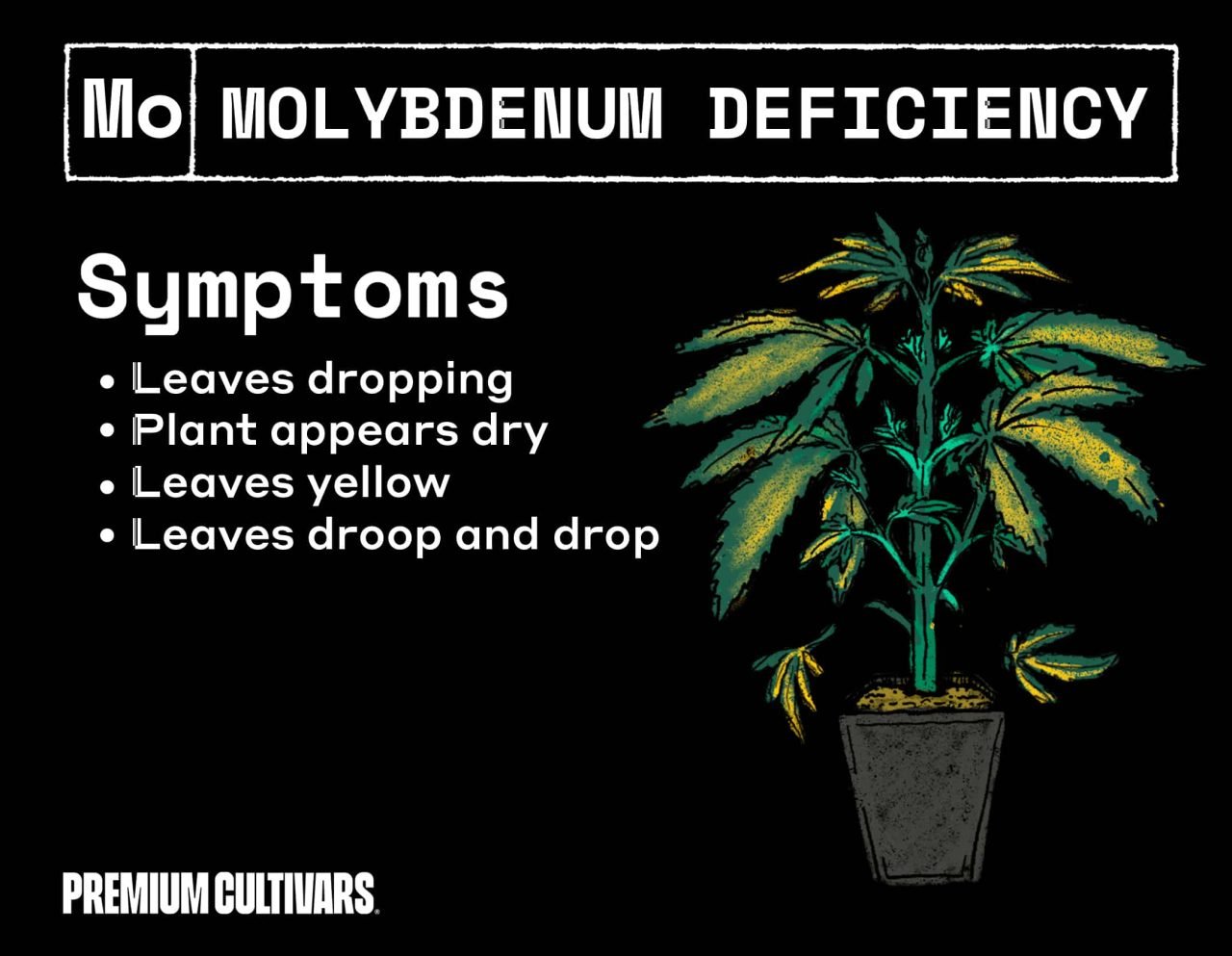
Molybdenum deficiencies usually show up in older leaves first, with interveinal chlorosis (yellowing) and later tissue necrosis (death). You may also notice leaf curling, stunted growth, and reduced flowering.
To treat a Molybdenum deficiency in organic grows, you can use compost or plant-based fertilizers like kelp or alfalfa meal. Inorganic growers can use a Molybdenum supplement like sodium molybdate to add to their nutrient solution. Just be sure not to overdo it, as too much Molybdenum can also have adverse effects on your plants’ flower production.
Silicon is another immobile micro, and has gained a fair bit of attention in the commercial cultivation world over the past few years. It is crucial in building and strengthening cell walls, making plants more resistant to pests, diseases, and environmental stresses. But it is also a great additive if you want to increase the overall strength of your crop, so there are now a bunch of liquid silicon nutrient additives available on the market.
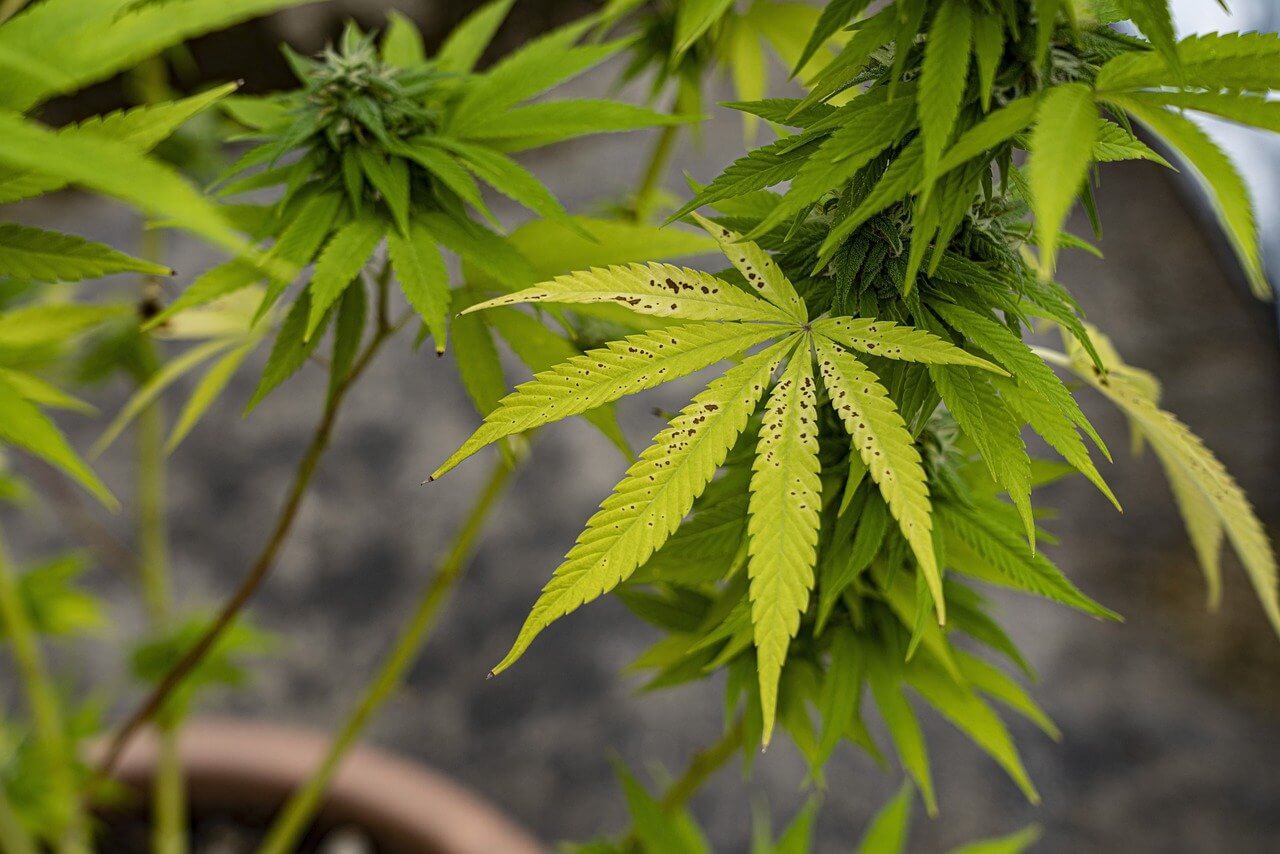
Symptoms of a silicon deficiency can vary, but often include stunted growth, weak stems, and decreased flower production. New leaves may also show signs of yellowing or browning around the edges, and your crop will be more susceptible to pest infestations.
To fix a silicon deficiency, grab a bottle of a silica-based additive like Silica Blast and apply through either foliar or root feeding. You can also use a silica-rich compost mix for organic grows.
Sulfur is an immobile macro that plays a crucial role in the production of chlorophyll and terpenes. It also helps regulate water use in plants, helps break down fatty acids, boost respiration, and aids in the formation of seeds and proteins.
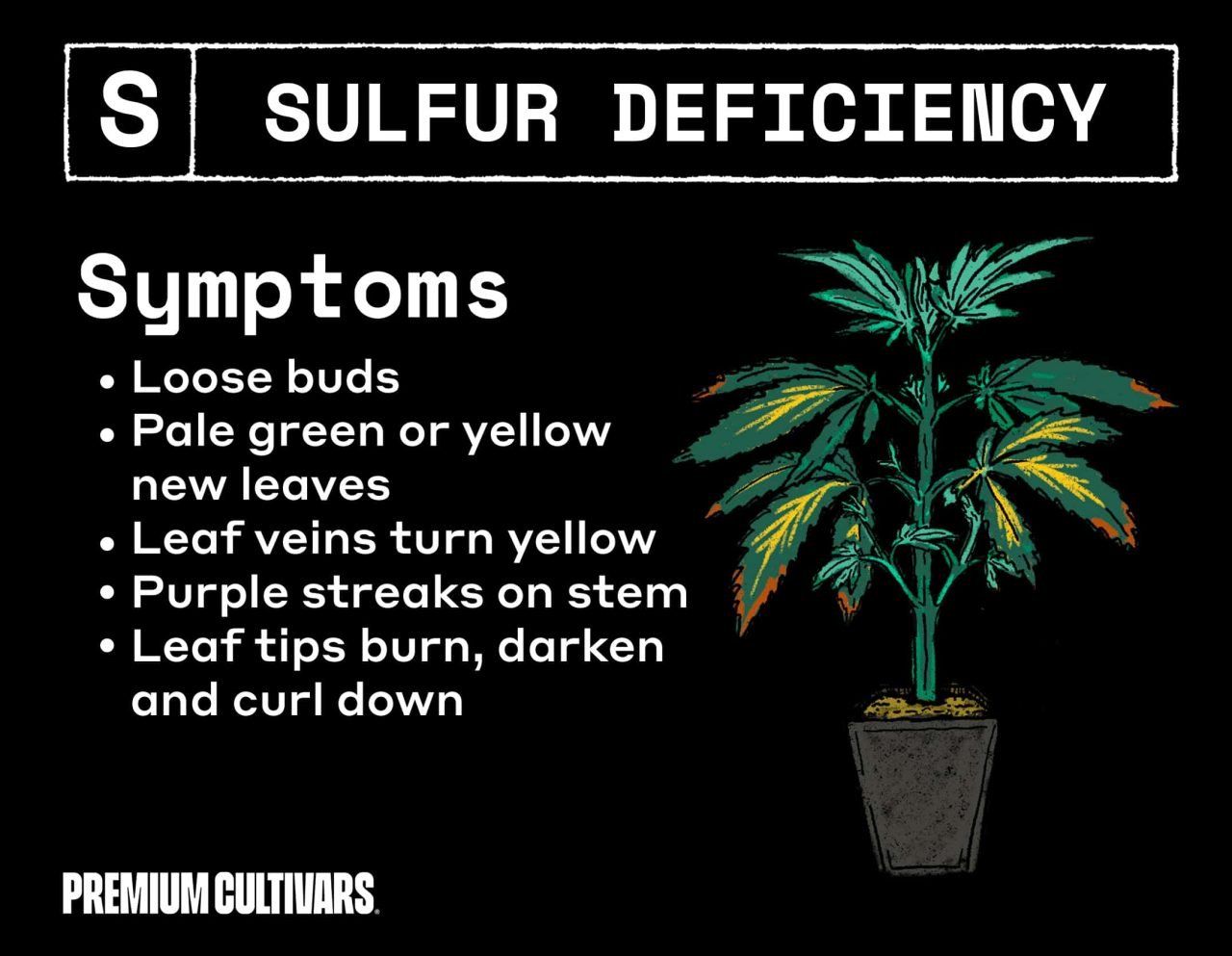
Sulfur deficiencies usually show up on newer leaves first, with the leaves first turning a weirdly bright green before yellowing between the veins. As it progresses, the whole leaf will turn pale green, the main stem of the plant can take on a very woody appearance, and you may see purple streaks appear along the whole length of the main stem.
Epson salts are sulfur-rich, and can be used as a quick fix for sulfur deficiencies in both organic and inorganic grows. Organic growers can also use compost or animal manure to increase sulfur levels, but once again, always use these remedies in moderation.
Last but not least, we have zinc. Zinc is immobile and is responsible for regulating hormones and sugar production, while also aiding in photosynthesis and root development. Ensuring that the root zone has a healthy amount of microbes is vital in ensuring that the plant is able to uptake the correct amount of zinc, so you might want to consider adding some mycorrhizal fungi to your grow regimen.
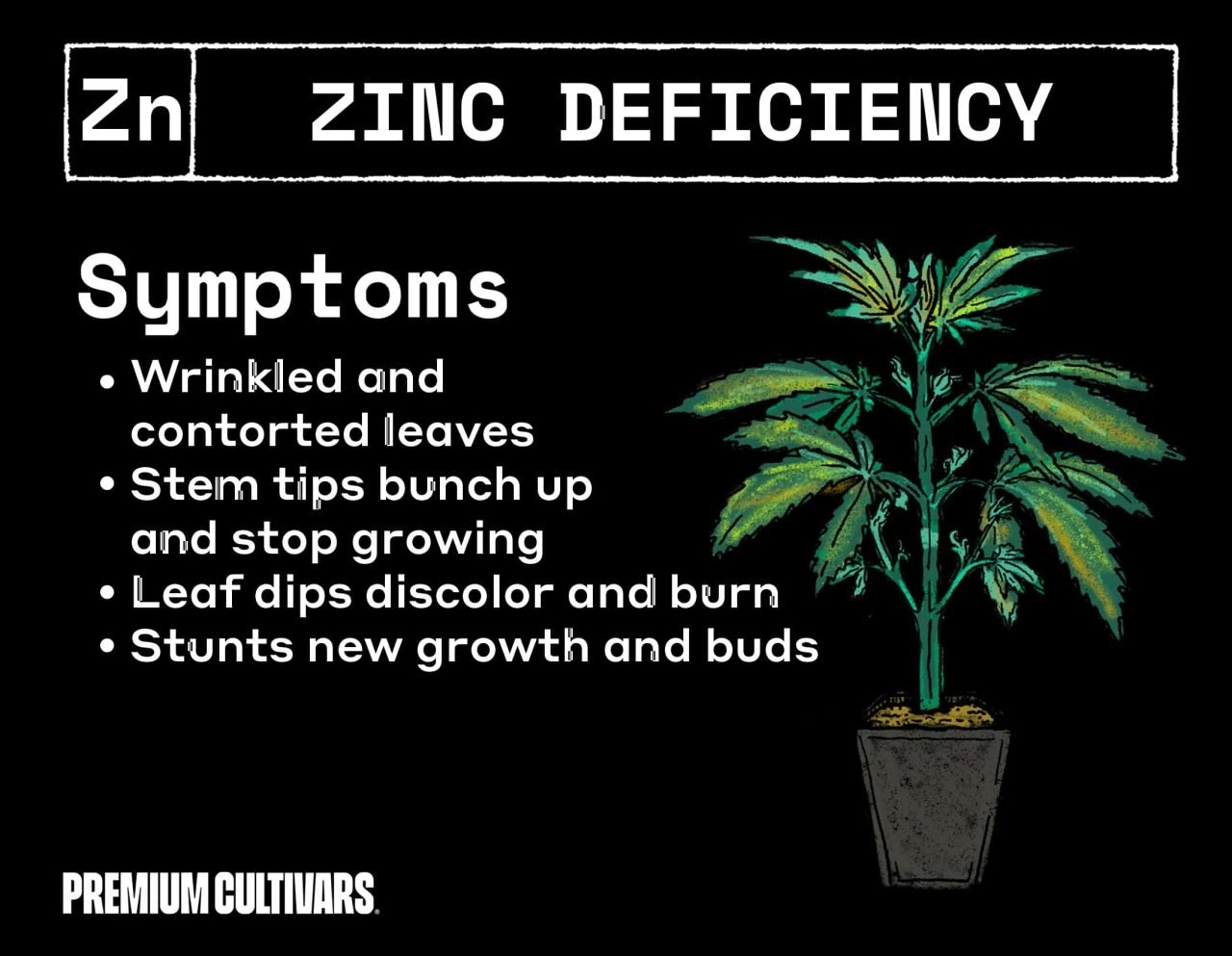
Symptoms of a zinc deficiency include chlorosis (yellowing) between the veins on new leaves, which may also not develop properly and twist, stunted growth, and reduced flowering. If left untreated, the leaves will also take on a wrinkled and distorted appearance, with the tips showing signs of burning.
To treat a zinc deficiency, there are a few options on the table. For organic growers, a zinc-rich compost or manure mix can be used. Inorganic growers can opt for a micronutrient supplement that includes zinc, or use Zinc Sulfate to add to their nutrient solution.
If you are growing your weed plants or crop in organic soil, then it’s all about making sure that the soil mix is up to standard before you begin cultivating. This includes sourcing nutrient-rich composts and fertilizers, ensuring proper drainage and aeration, and keeping pH levels in check. Sure, you may have to throw a few additives or amendments into the mix during the growing season, but for the most part, a good quality organic soil should be able to provide all of the necessary nutrients for your cannabis crop for the entire growing cycle.
There are so many cannabis-specific organic soil options now available, so get out there and do your research. Just remember, organic doesn’t necessarily mean slow release – a lot of the store-bought options include chicken manure and other fast-feeding fertilizers that can provide a quick hit of nutrients to your plants, but these may also be too nutrient-heavy for young cannabis plants. It’s always best to grab your soil from a reputable source that has proven to be successful for cannabis cultivation.
Your other option is to mix up your own super-soil. This will probably save you a fair bit of cash, and is a great option if you are looking to grow a huge crop and need a lot of soil. However, it can be a bit more labor-intensive and requires more knowledge on your part to ensure you get the right balance of nutrients.
We have gone over the huge importance that regulating the pH levels can have on a cannabis crop, but if you are growing in organic soil, it is actually not the biggest deal. That’s because good quality organic soil naturally buffers pH levels, making it less of a concern. However, if you do see your plants suffering from any deficiencies or stunted growth, it is still worth checking the pH levels to make sure they are in the optimal range for cannabis growth (around 6.0 to 7.0 for soil)
Hydroponic, coco-coir, or other soilless mediums require regular feeding to ensure that the plants have everything they require at all times. This requires you to mix up a nutrient solution (or using powdered nutrients, although this isn’t super popular) and making sure it is at the correct pH and PPM (parts per million) levels before applying it to your plants. This can be a bit intimidating for beginners, but you can easily find feeding schedules and instructions on how to mix up the solution correctly. You must, I repeat, YOU MUST check the pH and PPM before every single feed.
So there we have it. You’re all-in-one guide on how to prevent, identify, and treat every single cannabis deficiency that you could ever run into.
The key things to take away from this article are to always be vigilant with your plants (prevention is the best form of defense), observe any changes in color or growth carefully, and stay on top of your feeding schedule. It’s also important to remember that less is more when it comes to adding nutrients – always start with a lower dosage and work your way up if necessary.
With this knowledge in hand and some proper plant care, you can ensure a healthy and bountiful cannabis crop, free from any pesky deficiencies. Remember to have fun with it – after all, growing weed is an art form that we are all now lucky enough to be able to enjoy.
If you’re starting out, get messy and have a good time experimenting with different methods and techniques. That’s how you learn, and that’s what makes it so rewarding. Now go forth, grab some seeds, and grow the very best sticky-icky possible!
Best Selling Cannabis Seeds
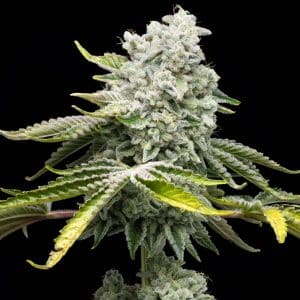
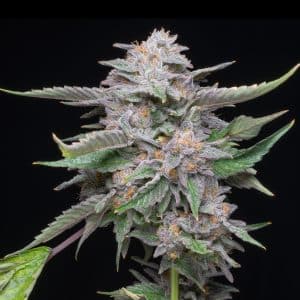
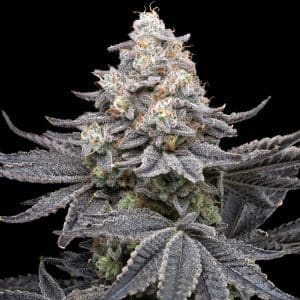
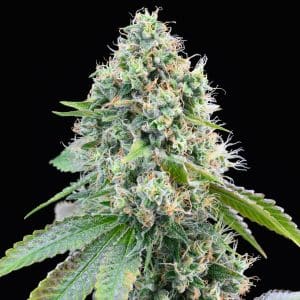
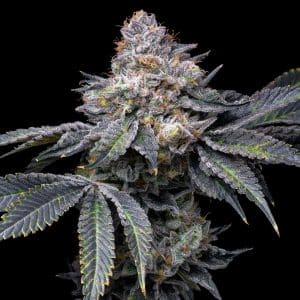
This product is not for use by or sale to persons under the age of 18. This product should be used only as directed on the label. It should not be used if you are pregnant or nursing. Consult with a physician before use if you have a serious medical condition or use prescription medications. A doctor’s advice should be sought before using any hemp products. All trademarks and copyrights are property of their respective owners and not affiliated with nor do they endorse this product. These statements have not been evaluated by the FDA. This product is not intended to diagnose, treat, cure or prevent any disease. By using this site you agree to follow the Privacy Policy and all Terms & Conditions printed on this site. All products contain less than 0.3% Cannabinoid-compliant with applicable Federal Laws. Please make yourself aware of any and all applicable laws regarding hemp in your jurisdiction. Premium Cultivars accepts no liability or responsibility regarding germination laws in any specific locale state or national jurisdictions.
We want to help you get your hands on the seeds you want, take 30% off your next purchase when you enter your email below!
We want to help you get your hands on the seeds you want, take 20% off your next purchase when you enter your email below!